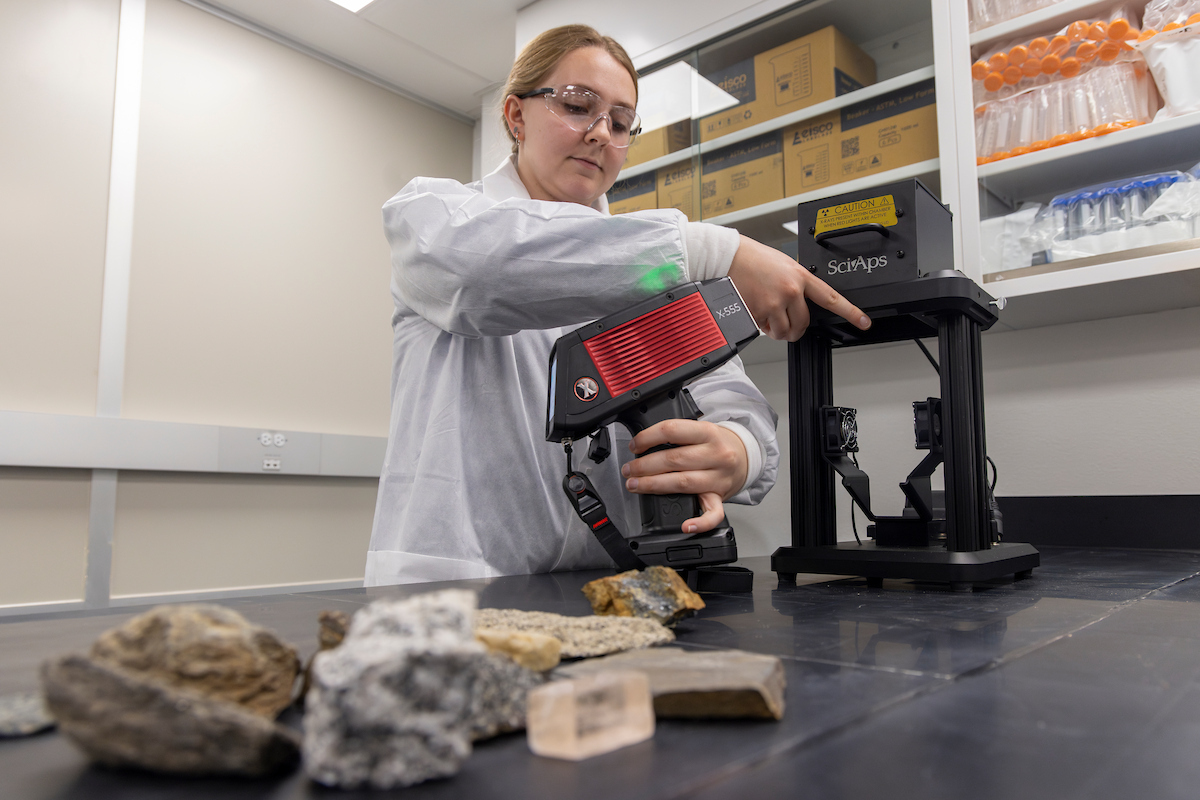Did You Know UAF is a national finalist to lead U.S. critical minerals innovation?
November 11, 2025
As the United States works to secure the materials that power clean energy and defense technology, the University of Alaska Fairbanks has landed among 15 finalists in a major National Science Foundation competition that could help reshape the nation’s mineral supply chain.
UAF’s proposal, to create the Alaska Critical Mineral Accelerator, aims to make the university a national hub for research, technology, and workforce development tied to the growing demand for critical minerals.

Lee Ann Munk of the University of Alaska Fairbanks Geophysical Institute at a National Science Foundation event in Washington, D.C., on Sept. 18, 2025.
Building momentum
The NSF’s Regional Innovation Engines competition drew nearly 300 applications from across the country. UAF’s proposal,
led by the Alaska Critical Minerals Collaborative (ACMC) within the Geophysical Institute, advanced through several review rounds to
reach the final stage.
The ACMC brings together university scientists, state and federal agencies, and industry partners to investigate and develop Alaska’s mineral resources.
Winners are expected to be announced in early 2026, with selected regions potentially receiving sustained investment over a decade to strengthen local innovation.
“It’s really an epic accomplishment for UAF,” said ACMC Director Lee Ann Munk. “We have never had an opportunity like this around critical minerals. This can be the catalyst for UAF and Alaska to be central to a domestic supply of critical minerals.”
Additional funding for the program, including funding for the current proposals, is contingent on Congress and the White House providing sufficient funds to the NSF to sustain it.
Turning research into results
Alaska holds 53 of the 60 critical minerals the U.S. Geological Survey considers critical
to the national economy. Yet much of the state remains under-mapped and under-explored
with an abundance of minerals to supply the domestic supply chain.

Research Professional Piper Kramer showcases the Critical Minerals Lab on the second floor of the Duckering Building at UAF, Nov. 1, 2024.
At UAF, researchers are testing technologies that extract critical minerals from existing mine waste, what Munk calls “turning waste into wealth.” ACMC has become a bridge linking an industry-academia-government-non-profit coalition eager to collaborate in Alaska.
National attention on Alaska’s mineral potential has also intensified. Earlier this month, the federal government approved construction of the Ambler Road Project, a proposed 211-mile industrial road that would provide access to the Ambler Mining District in northern Alaska. The region contains significant deposits of copper, cobalt, gallium, and germanium, minerals considered critical for clean energy, technology, and defense manufacturing.
The project has drawn both support and opposition. Supporters cite its potential to strengthen domestic supply chains, while others have raised concerns about environmental and community impacts. The renewed debate highlights the complexity of developing Alaska’s mineral resources and the importance of research, data, and collaboration to guide responsible decisions.
The Institute for Energy Research recently described Alaska’s resource potential as “strategically essential to American critical-mineral independence,” noting that greater domestic production could reduce reliance on China for materials vital to national security and emerging energy technologies.
One such partnership involves Northern Star Resources, operator of the Pogo Mine near Delta Junction. The company approached UAF with a mineral recovery challenge, and researchers have spent the past year developing solutions. The collaboration is part of UAF’s NSF proposal and shows how industry needs are driving new university research.
“We needed to be doing this ten years ago,” Munk said. “But we’re finally catching up.”

Inside the Critical Minerals Laboratory at the University of Alaska Fairbanks, Research Professional Piper Kramer prepares data for analysis using specialized instruments that help identify and measure trace elements, Nov. 1, 2024.
Workforce on the rise
To meet growing demand for skilled workers, UAF is expanding its training programs
through the Mining and Petroleum Training Service (MAPTS), a statewide workforce initiative housed at UAF’s Community and Technical College.
New courses are being designed to prepare Alaskans for jobs in critical minerals production.
If the NSF proposal is funded, part of the investment would go toward workforce development, expanding MAPTS programs and strengthening Alaska’s in-state talent pipeline.
“We want to hire more Alaskans,” Munk said. “But we have to provide the right training. You outsource when you don't have it yourself.”
The long view
Munk says the state’s success depends on industry, government, academia, and nonprofits
working together, something that has not always happened in the past.
“We’re trying to make up for 30 years of lack of focus on critical minerals in three years,” she said. “But I do see a shift happening.”
If Alaska continues building on this momentum, the university’s research could play a central role in informing how the nation develops its critical mineral resources.
Go deeper
Learn more about critical minerals research and training at the University of Alaska.
Read the full press release from the Geophysical Institute.
- Lee Ann Munk, University of Alaska Fairbanks Geophysical Institute, lamunk@alaska.edu
- Rod Boyce, University of Alaska Fairbanks Geophysical Institute, 907-474-7185, rcboyce@alaska.edu
